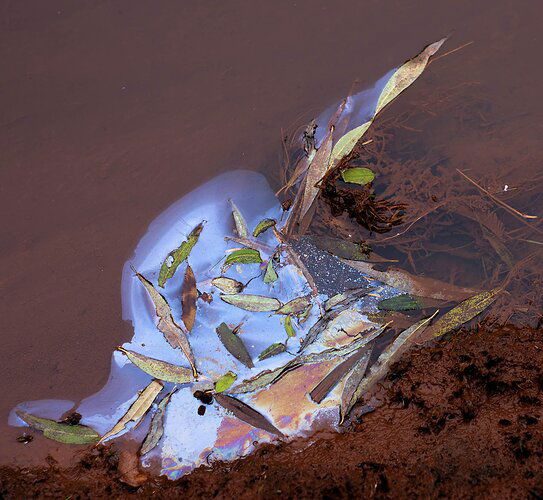The film on the water is no oil, but it is caused by iron-oxidizing bacteria.
An image I made a few years ago, but I reprocessed the file and decided for a crop. This is normally not my kind of photography, but I liked the scene.
Type of Critique Requested
- Aesthetic: Feedback on the overall visual appeal of the image, including its color, lighting, cropping, and composition.
- Conceptual: Feedback on the message and story conveyed by the image.
- Emotional: Feedback on the emotional impact and artistic value of the image.
Specific Feedback and Self-Critique
Any comment welcome.
Technical Details
Pentax K5, Pentax K 1.8/55mm, ISO200, 1/80s. No exif-data about the aperture (probably large); I was carrying 2 old manual lenses while walking around (the 55mm and a 1.8/85mm). Fun to play with the old technique, once in a while.
2 Likes
Han, quite an interesting image especially with the film on the water and the leaves. Seems like the scene is a rare find but I’m not sure of the scientific phenomenon. It certainly makes me think of the recent train derailment in Ohio and the environmental impacts. Regarding aesthetic, the overall exposure looks good. I think a tighter crop on the leaves and film and excluding everything else would be interesting.
Thank you @Alfredo_Mora for your comment. I’ll definitely try the tighter crop that you suggest.
The train derailment in Ohio is probably an environmental disaster. The film in my image isn’t. As far as I know the bacteria are more or less innocent, although they can cause clogging. But the optical effect of the film is very similar to e.g. an oil film on water.
1 Like
Han, there are a couple of places locally where I sometimes see a similar effect, due to lots of clay in the soil giving up natural oils (or surfactants) as it biodegrades. Those materials float on the water and are thin enough to show different colors via the phenomenon called thin film refraction. (That phenomenon is also why oil pollution shows similar colors.) I’m enjoying the leaves scattered in the oil and the nice pointer toward the UR.
Han,
This is quite fascinating! Aside from the colors created, I find it fascinating the all the leaves are congregated to the oils - probably some sort of capillary effect - although I’m no scientist…
I love what’s being presented with the leaves and colors in the primary area of the image, but wishing there wasn’t so much empty space in the UL quadrant… Then again, I appreciate that there really is no viable crop without compromising the extented leaves reaching out diagonally… So I think you’ve framed this the best it could be. Still, love the colors and the natural arrangement you’ve captured.
Lon
A very interesting find and composition. The relatively empty area in the UL feels a bit awkward but there isn’t much to do about it. I’ll often add a darker gradient to deal with that kind of problem. Maybe angling the camera could have given a different composition but the image has a lot of interest and stands up well as is.
I assume this was in The Netherlands, but the leaves look so much like our Eucalyptus – maybe it has been imported there, too? Iron bacteria is endemic in the groundwater in my part of California, and is a real nuisance for clogging pipes and drip irrigation systems. Water comes out of the well pristine clear but with a distinct odor, and deposits a brown oily slime after contact with air.
Thank you @Lon_Overacker , @Mark_Seaver and @Diane_Miller for your comments.
I agree, that the UL is empty, and indeed this can’t be easily fixed in PP. I like @Diane_Miller 's suggestion to use a gradient.
The scene is in The Netherlands, but the leaves are not Eucalyptus but Willow. Eucalyptus has not been imported here, but there are many plantations of imported Eucalyptus in southern Europe, mainly for the paper mills. They are an ecological disaster because Eucalyptus needs lots of water.
Han, this is such an interesting image, looks it could have been a double exposure, and my eyes are drawn to the tiny leaves which are nicely framed in the oily film. The monochromatic background really makes it stand out nicely and the whole mini-scene was well captured.
1 Like
